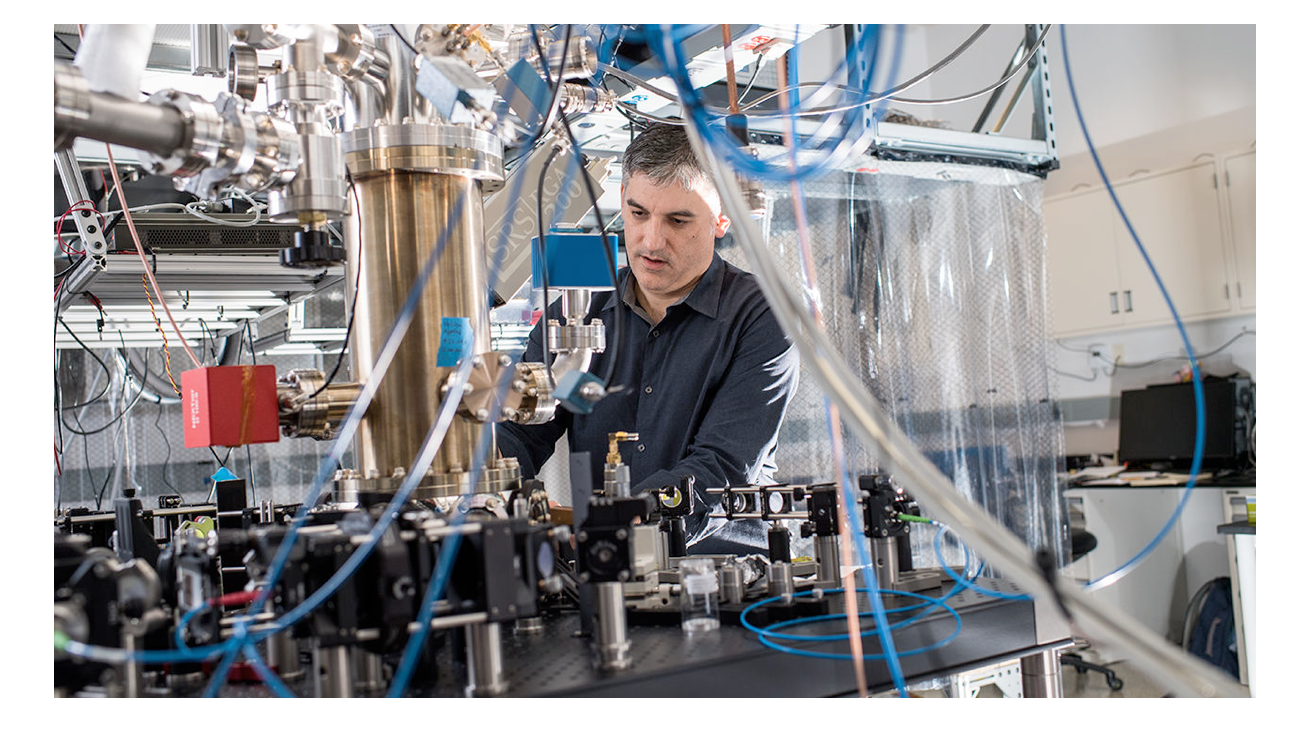That's what life-giving quantum does.

Today, quantum computing is one of the strategic directions of development, to which large corporations and research centers pay great attention. And although in the press from time to time it is reported about the next achievements in the creation of quantum computers, so far we are talking mainly about experimental products for testing ideas and technologies. It is still difficult to use such computers in life. But it is likely that it is in 2017 that we will have a breakthrough in the field of practical application of quantum computers.
Minute literacy
Just in case, we recall what quantum computing is. Classic computers perform calculations using bits that can be in one of two states — 0 or 1. Quantum computing uses quantum bits — quantum bit, qubit, qubit. Due to the phenomenon of quantum superposition, qubits can be in one of three states — 0, 1, 0, and 1 simultaneously . This allows quantum computers to solve certain types of complex algorithmic problems that conventional computers either do not solve at all or they solve for a very long time.
')
Today there are several different approaches to obtaining qubits, each of which has strengths and weaknesses. For example:
• Superconducting circuits - elements in which electrical current circulates without loss. Controlled by an external source of microwave radiation. They can be built on industrial superconductors, but they are very unstable and require the maintenance of ultra-low temperature.
• Ions in vacuum traps - with the help of lasers you can change the energy of ions and put them into a state of superposition. Very stable, but not very fast and require the use of a large number of lasers.
• Silicon quantum dots - electrons are added to tiny pieces of silicon, controlled by an external source of microwave radiation or lasers. Stable, created on industrial semiconductors, but require maintaining an ultra-low temperature and are difficult to scale.
• Topological qubits - in the behavior of electrons traveling through semiconductor structures, patterns can be distinguished, with which you can encode quantum information. This idea has a low level of errors, but its validity is not confirmed.
• Nitrogen-substituted vacancy in diamond - a diamond crystal lattice defect associated with a nitrogen atom. Laser control. It works at room temperature, but is difficult to scale.
The power of quantum computers lies in the exponential scalability of their computing power. Two-qubit machines simultaneously perform 4 calculations, three-qubit - 8 calculations, 4-qubit - 16, and so on. The promise of quantum computers is that one processor for 50-60 qubits in a number of tasks can be more productive than the Chinese supercomputer Tianhe-2 , which occupies half the size of a football field, consumes 20 megawatts of energy and costs about $ 400 million .

Experts expect the appearance of quantum computing devices that can compete with supercomputers over the next year and a half.
On the threshold of revolution
Today, quantum computers, Google, Lockheed Martin, Los Alamos Laboratory, Microsoft, IBM, Intel, Rigetti Computing, D-Wave and many other corporations, companies and laboratories are working on creating quantum computers. According to Gartner analysts, quantum computing technologies are at an early stage of their development:

Quantum computers will reach a “productivity plateau” in more than ten years. This means that in 2017-2018, the appearance of the first samples is very likely, which will be more versatile in use. The fact is that modern developments are completely impractical for everyday use. Qubits are unstable and can easily be removed from the state of superposition, while quantum computers themselves are complex installations that are very demanding on environmental parameters.
In addition, quantum computers are extremely complex in programming, since this requires very specific knowledge. For the overwhelming majority of practical problems, one has to use intermediate means of converting into the languages of quantum computers, which reduces to no their main advantage — incredible performance. Therefore, the development of quantum technologies goes in two directions: the improvement of the hardware and the development of new approaches to programming.

Quantum computers to the masses
Last year, IBM launched a cloud service that allows it to run third-party programs on a corporation-owned quantum computer. And one of the most famous developers of quantum computers, the Canadian company D-Wave, created the open source tool Qbsolv. It is designed to help developers program D-Wave computers without having to go into the wilds of quantum physics. Qbsolv can be called an attempt to impart a human face to quantum programming. This is a very correct step, given the complexity, novelty and incomprehensibility of quantum computing, very few IT specialists are fully aware of the importance of this technology as far as it can change our life.
About a year ago, another free tool appeared - Qmasm , which lightens the burden of writing code for D-Wave computers. It saves programmers from having to think about addressing a particular hardware. Both of these initiatives, Qbsolv and Qmasm, are designed to draw the attention of the developer community to solving problems specific to quantum computing. True, to run the programs created using these tools, you will need access to one of the D-Wave computers, but you can also use the simulator available for download. Of course, these are unequal options, but at least something to begin with.

D-Wave quantum computers are today considered among the most advanced. They are built on the principle of quantum annealing (quantum relaxation) and are designed for a very narrow range of tasks: solving optimization problems. A classic example is the traveling salesman problem : the calculation of the shortest closed route that passes through all given points.
Several years ago, D-Wave machines were widely criticized, and even their quantum nature was questioned. In 2013, a consortium of Google and NASA acquired a D-Wave quantum computer. In 2015, Google experts published a scientific paper in which they confirmed that the D-Wave computer actually uses the quantum effect for its calculations, and it can solve a specific, narrow problem 100 million times faster than ordinary computers. Now skeptics basically doubt whether the D-Wave computer as a whole can work faster than ordinary computers, and whether the underlying principle is more effective than the approaches of IBM and other developers.
From quanta to artificial intelligence, super medicines and other benefits
D-Wave developers say that the brainchild does not necessarily offer the most effective solution to optimization problems add fuel to the fire. The point is to give a solution, perhaps not perfect, but on the other hand, to do it very quickly. That is, the main purpose of D-Wave quantum computers is the solution of such problems for which the speed of finding a solution is critical, and not its accuracy.
Under this description fit numerous tasks in the field of artificial intelligence. Machine learning for the most part solves the problem of "pattern recognition". Algorithms shovel large data sets in search of signals in noise, and it is necessary to maximize the number of comparisons in search of a better model for describing this data. Quantum computers could solve such problems by orders of magnitude more efficiently, simultaneously comparing a huge amount of data and their transformations. This would allow much faster to come to much more powerful forms of artificial intelligence.

However, at least one sphere can be called for which the development of quantum computers is not a boon, but a nightmare - cryptography. Many algorithms, the robustness of which is based on the colossal length of enumeration of possible options using classic computers, with the introduction of quantum computing will instantly cease to be reliable. For this reason, for example, the US National Institute of Standards and Technology called on the government to be ready to switch to “post-quantum” cryptography by 2025. Michael Mosca, co-founder of the Institute for Quantum Computing at the University of Waterloo, and co-founder of EvolutionQ , came to the conclusion that with a probability of about 14% , quantum computers will be created by 2026 that can crack the encryption algorithms that are used today in critical systems. In other words, 10 years from now, cryptography in its current form may simply cease to be relevant. On the other hand, quantum computing will allow creating new, unprecedented algorithms.

Another important area of application for quantum computers is the modeling of complex molecular interactions at the atomic level. Soon we will be able to model all 20 thousand proteins encoded in the human genome, and begin to study the effects on them of drugs, both existing and those that will be created. Such depth of modeling will allow to develop remedies for diseases that today are considered incurable.
Modeling interactions at the atomic level will give us the opportunity to create new materials with unprecedented characteristics. Perhaps we can produce more efficient superconductors, more powerful magnets, more capacious and compact batteries, and so on.
Quantum computers will allow us to raise to a new level our understanding of the design of biological systems, the course of various processes characteristic of objects of living nature. Biomimetics will generate new incredible inventions, including new materials, more efficient energy storage systems, all kinds of machines and devices that use the principles of movement of various birds, animals and insects.
In other words, quantum computers will be one of the most important factors approximating the onset of technological singularity. What will happen after - no one can assume. It is like an event horizon for our civilization. And we rush to him at full speed.
Source: https://habr.com/ru/post/321900/
All Articles